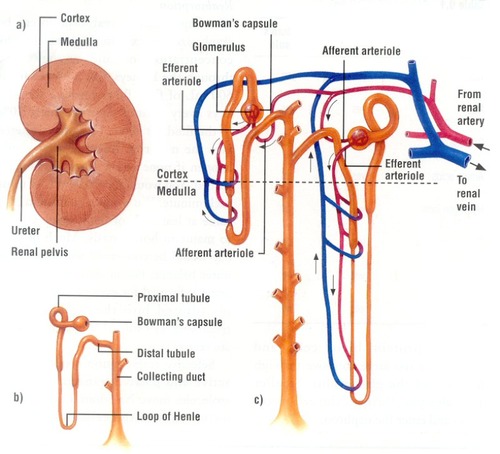Which of the Following Structures Drains Into the Collecting Duct
It is adjacent to the distal convoluted tubule the most distal segment of the renal tubule. Formed by the convergence of larger lymphatic vessels called lymphatic trunks.

Chapter 24 Urinary System Ppt Download
Renal corpuscle B loop of Henle C.

. It is the last segment of the nephron. Asked Oct 28 2021 in Anatomy Physiology by Murse. The left lymph duct or thoracic duct drains everything else including the legs GI tract and other abdominal organs thoracic organs and the left side of the head and neck and left arm and shoulder.
These veins join to form the superior vena cava the large vein that drains blood from the upper body into the heart. Following the PCT the loop of Henle a hairpin-like structure penetrates the medulla and returns to the cortex to connect with the distal convoluted tubule DCT. Finally the nephron drains into the collecting duct via connecting tubules.
What causes fluid in the lymph nodes. Distal convoluted tubule D. Toward the papillary tip converging papillary ducts form approximately 20 large ducts which empty into the renal pelvis.
Collecting ducts descend through the cortex and medulla and successively fuse near the inner medullary region. Proximal convoluted tubule C. Afferent arteriole glomerulus glomerular capsule collecting duct.
Peritubular capillaries glomerulus afferent arteriole renal vein b. These veins join to form the superior vena cava the large vein that drains blood from the upper body into the heart. With respect to the renal corpuscle the connecting tubule CNT or junctional tubule or arcuate renal tubule is the most proximal part of the collecting duct system.
The right lymph duct drains the right arm shoulder area and the right side of the head and neck. Which of the following structures drains into the collecting tubule. Asked Oct 28 2021 in Anatomy Physiology by Murse.
Which of the following structures drains into the collecting duct. The distal convoluted tubule is the portion of the nephron that empties into the collecting ducts. More than one structure can be affected by a sole disease as well as the interdependence of.
The hormone ADH is released from the. An average of six nephrons drains into a collecting duct. Passageway through kidney using the following terms.
Click to see full answer. The lymphatic vessels drain into collecting ducts which empty their contents into the two subclavian veins located under the collarbones. Collecting ducts descend through the cortex and medulla and successively fuse near the inner medullary region.
The structure of the kidneys is quite complex and includes a large number of these tubes in an interconnected drainage system. All parts of the kidney. Collect lymph from trunks.
Two collecting ducts drain all lymph fluid back to the blood thoracic ductreturns lymph form the body to the left subclavian vein andright lymphatic duct returns lymph from the upper body to the right subclavian vein. Toward the papillary tip converging papillary ducts form approximately. Small kidney-bean shaped organs associated with lymph collecting vessels that clean and filter lymph.
Distal convoluted tubule Which structure is included in the discussion of the urinary system even though is it part of the circulatory system. An average of six nephrons drains into a collecting duct. Glomerulus Bowmans capsule proximal convoluted tubule distal convoluted tubule Loop of Henle Collecting duct ureter urethra bladder renal arteries peritubular capilaries medullary.
The right lymphatic and thoracic ducts drain about an equal area of the body. Connecting tubules from several adjacent nephrons merge to form cortical collecting tubules and these may join to form. The lymphatic vessels drain into collecting ducts which empty their contents into the two subclavian veins located under the collarbones.
The right lymphatic and thoracic ducts drain about an equal area of the body. Loop of Henle. Drains lymph from right side of head and neck right shoulder and right upper limb.
Which of the following represents in order the path of a blood cell passing through the kidney. The collecting ducts are a series of small tubes inside the kidneys that funnel urine into the renal pelvis for drainage into the ureter. Once in the ureter the urine can be pushed into the bladder for elimination.

Structure Of A Nephron And Collecting Duct The Neighbouring Blood Vessels Associated With A Nephron Flashcards Quizlet

Structure Of A Nephron And Collecting Duct The Neighbouring Blood Vessels Associated With A Nephron Flashcards Quizlet

No comments for "Which of the Following Structures Drains Into the Collecting Duct"
Post a Comment